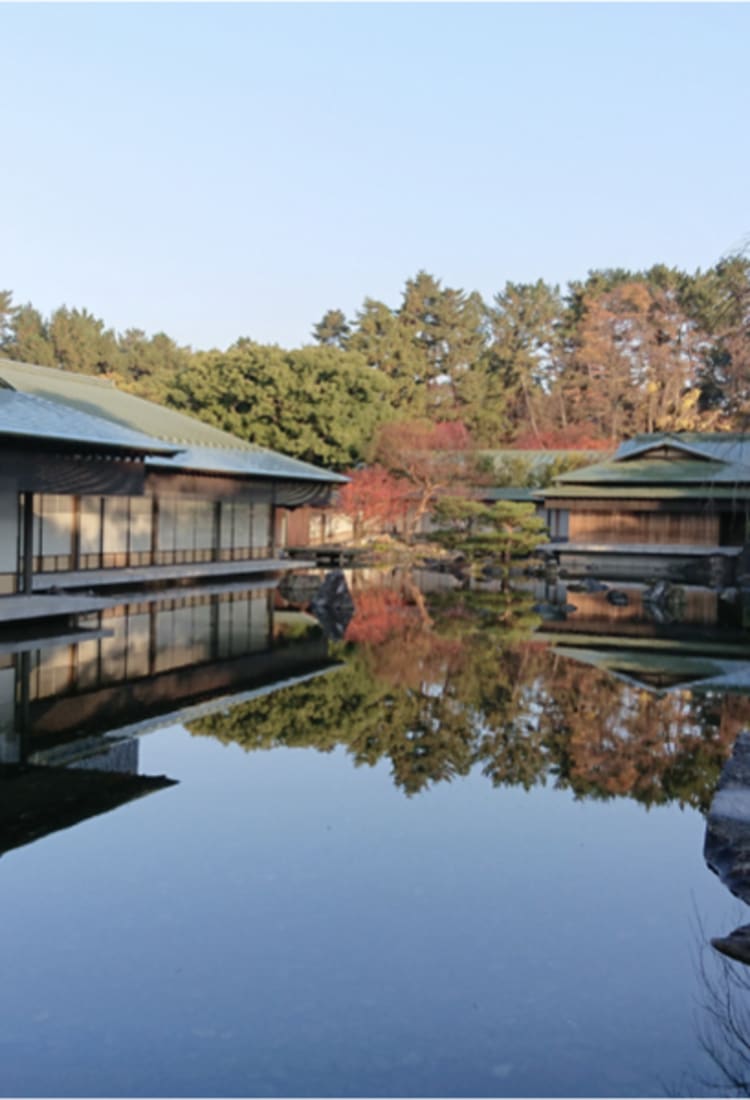
Experience the stunning legacy of traditional artistry on a journey through Kyoto’s winter charms
Experience the stunning legacy of traditional artistry on a journey through Kyoto’s winter charms
The architecture, interiors, and furnishings of the Kyoto Geihinkan showcase the city’s artisan traditions
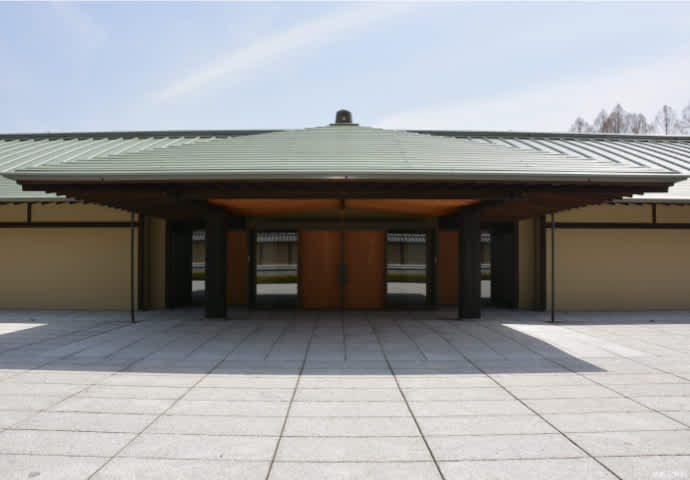
If you’ve been reading up on the Japan travel experience, you’ve surely heard the word omotenashi, used to describe the country’s unique approach to warm hospitality. The concept of omotenashi includes guest interactions, meal presentations, and much more. The Kyoto Geihinkan was designed to welcome foreign dignitaries to Japan and show them great respect while introducing them to the wonders of Japanese traditions and culture. In that sense, it unquestionably represents the ultimate expression of the country’s omotenashi spirit.
The Kyoto Geihinkan was completed in 2005, and opened to the public in 2016. Visitors are greeted by an oversized front door crafted from a single piece of keyaki wood. Its restrained height allows the exterior of the structure to convey a sense of humility. The interior of the entryway features a design that is simple, yet elegant and sophisticated.
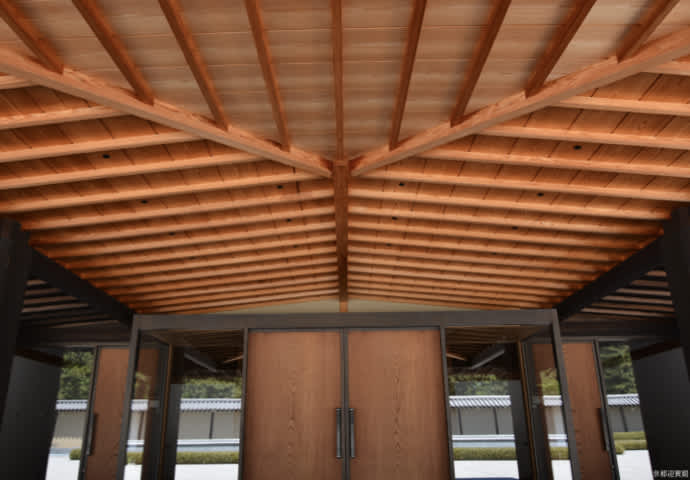
The Kyoto Geihinkan has both Japanese and Western-style dinner rooms to accommodate official functions as well as meeting rooms equipped to handle ministerial conferences and similar gatherings. The garden is a place to experience the delights of Japan’s four distinct seasons. The Geihinkan is designed so that the building and garden function in an integrated, harmonious way. Meanwhile, Kyoto’s proud artisan traditions are everywhere you look—in every room, in every hallway and pillar connecting them—even in the tiniest garden details. In this way, the Kyoto Geihinkan is as much a museum showcasing traditional Kyoto craftsmanship as it is a State Guest House.
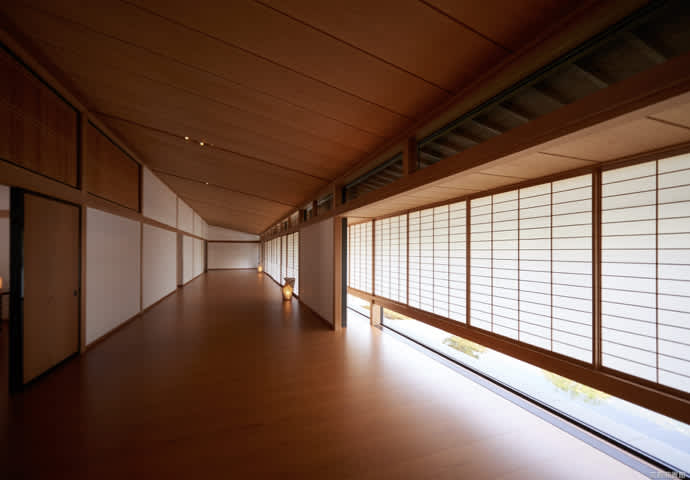
The hallways, for example, are made from keyaki plank floors, plaster walls, and sugi cedar ceilings. It is a simple construction that is at once sophisticated and understated. Traditional crafted pieces like paper lanterns can be found throughout the building, while a look out the windows offers views of a traditional Japanese garden. Even the time spent moving from room to room is pure delight.
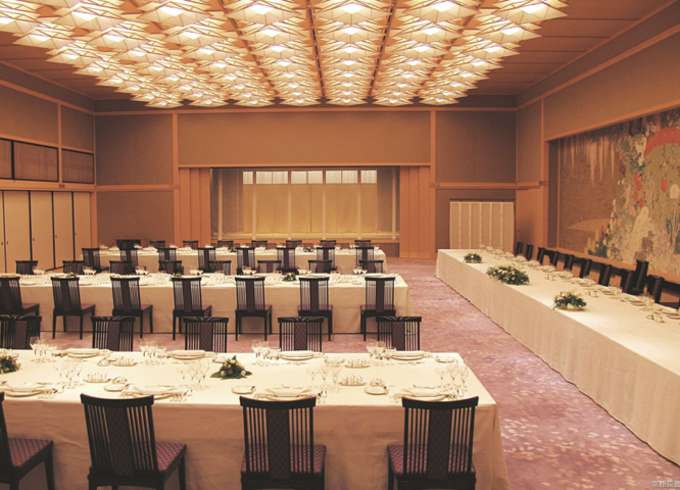
The largest room at the Kyoto Geihinkan is the Fuji-no-ma (Wisteria Room), which is used to host evening banquets. It is a lavishly appointed space capable of being converted in a variety of ways. The wall at the head of the room is draped with a handwoven tsuzure-ori tapestry*1 showing thirty-nine flowering plants native to Japan, including the wisteria.
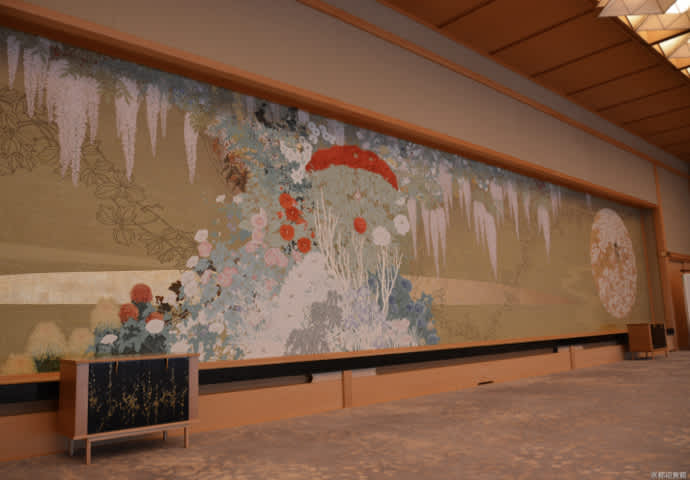
Look up at the ceiling and you will find a dimensional light structure that incorporates traditional Kyoto woodworking techniques known as kyo-sashimono, where joints rather than nails are used to link wood pieces together. The individual lights can be moved up and down to create fifteen different lighting patterns, making it the perfect design for this opulent dining space.
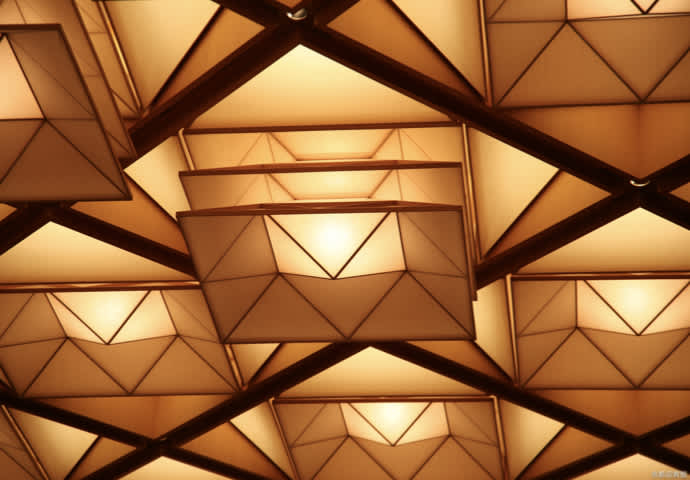
The exquisite detailing on the furnishings at the Kyoto Geihinkan—including its dining table, display stand, and serving table (baggage stand)—is not to be missed. Highlights include glimmering ornamentation techniques like raden, which takes mother-of-pearl slivers cut into a variety of shapes and sets them into lacquer or wood surfaces, and makie, which sticks gold, silver, or other colored powders on top of lacquer to create patterns and designs.
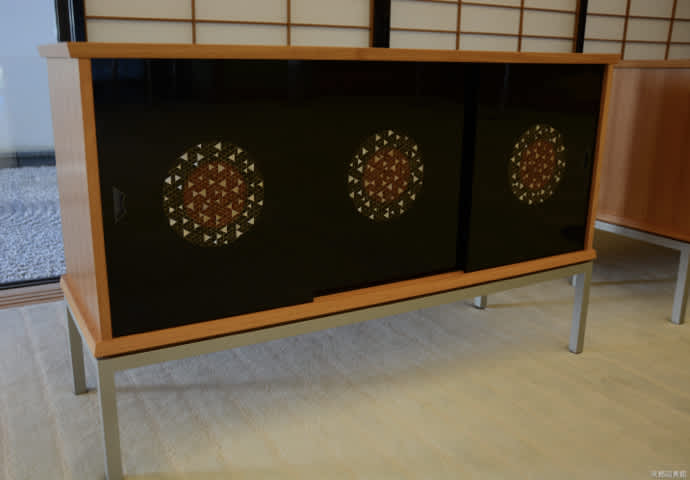
There are two ways to see the Kyoto Geihinkan. Visitors are either free to wander around as they please or take a guided tour with an English-speaking guide. Tour schedules and other details are available on the Geihinkan website, so be sure to check them before planning your trip.
*1 Tsuzure-ori is a type of textile where multicolored threads are woven through the weft thread, with artisans adjusting the position of the weft each time it loops back to create elaborate designs.
Experience artisan techniques firsthand at a traditional workshop
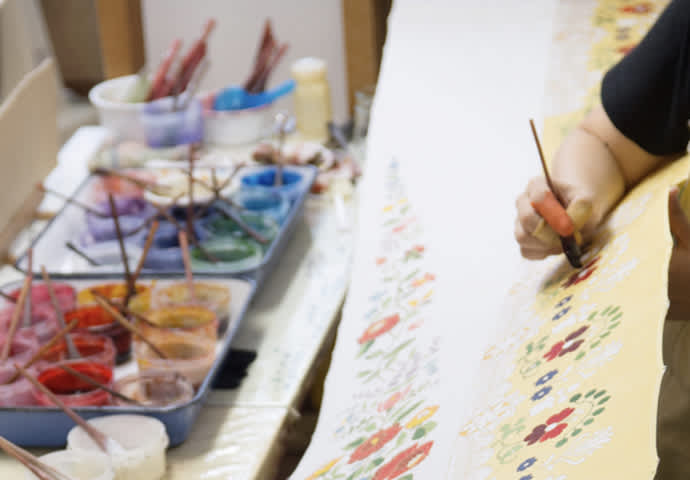
The traditional craftsmanship at the Kyoto Geihinkan is a feast for the eyes, and it’s likely to spark the desire to take a piece of Kyoto’s artistry home for yourself. And how much better if you actually had a hand in its creation!
Luckily, there are places in the city that cater to just this kind of desire. The Kyoto Artisans Concierge is a website dedicated to connecting visitors with artisan workshops where they can watch and experience Kyoto’s traditional industries, and you’re sure to find information on all kinds of fascinating programs there. The site (which is available in English) allows you to search for tours or hands-on craft workshops featuring all kinds of Kyoto craft traditions, including nishijin-ori textiles, kyo-yuzen dyeing, kyo-yaki and kiyomizu-yaki pottery, metalworking crafts, kyo-shikki lacquerwork, and more. You can even narrow your search according to region, budget, time available, and other parameters, and the site has a handy list of guidelines so you can be confident of knowing the proper etiquette during your visit as well.
With nishijin-ori textiles, for example, you can actually become an artisan’s apprentice for a day and work on an actual piece. Get the full experience with a 3.5-hour package, or take a 1.5-hour tour that includes working on an accessory for ¥5000 or less.

At a kyo-yaki and kiyomizu-yaki pottern studio, you can not only watch up-close as potters craft their wares, but also choose a package that includes a take-home gift or an actual pottery-making workshop. There are fun shopping opportunities to take advantage of as well*2.
*2 Available packages at individual studios are subject to change. Make sure to confirm availability in advance.
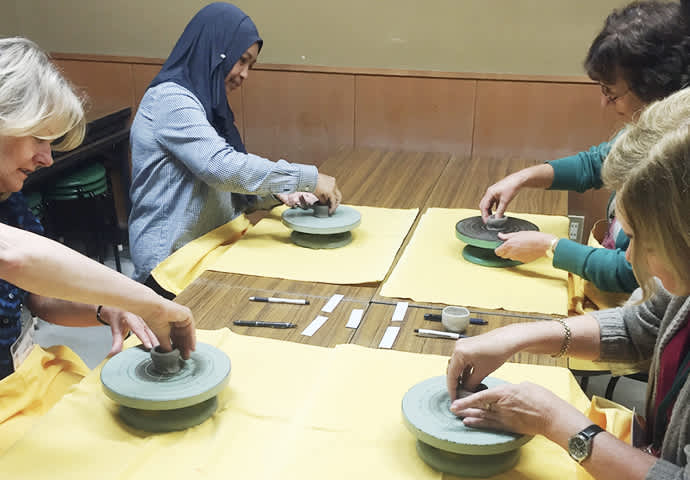
What better way to create lasting memories than to try experience some of the craft traditions of the Kyoto Geihinkan for yourself?
Catch a rare, snow-covered glimpse of Kyoto’s National Treasures and Important Cultural Properties
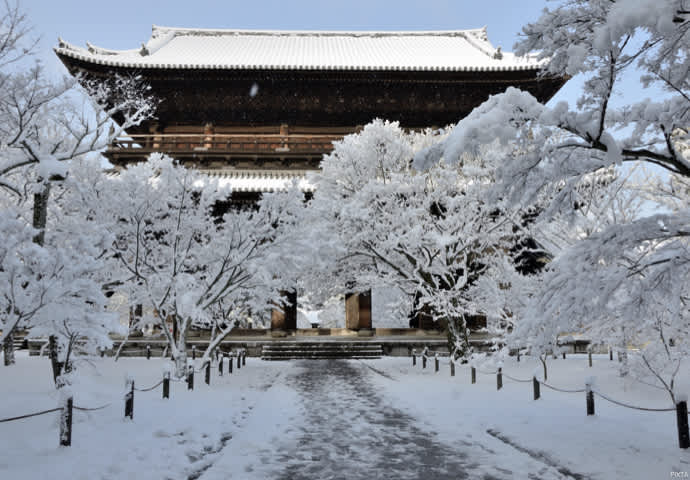
Kyoto is a treasure trove of cultural properties, including the seventeen temples, shrines, and castle ruins that comprise its official World Heritage designation as the Historic Monuments of Ancient Kyoto. It is a city unlike any other in the world, with such an abundance of shrines and temples that there is simply no way to see them all.
Kyoto is stunningly beautiful no matter when you visit, but winter affords a reprieve from the seasonal crowds and even the possibility of snowfall in late January or February. Kyoto’s sacred sites simply look gorgeous blanketed in snow.
Because Kyoto’s temples and shrines are scattered throughout the city, there’s a limit to how many you can visit the same day you see the Kyoto Geihinkan. If you’re lucky enough that snow falls during your visit, however, do everything you can to hit the following key destinations.
Nanzan-ji Temple is one popular spot that affords multiple sightseeing highlights. Its Sanmon gate has been nationally designated as an Important Cultural Property, and visitors are allowed to go up to its second story. From there, you’re afforded a sweeping view of the entire temple grounds. The Hojo (abbot’s quarters) is another historical structure that is said to have been built around the 16th century and later moved to its current location. The paintings decorating the sliding fusuma doors in the building’s interior are spectacular. There is also a soothing Japanese rock and sand garden.
Another can’t-miss sight is the five-story pagoda at Toji Temple, which has been designated as a National Treasure. Standing 58.4 meters in height, it is the tallest wooden structure in Japan. Lightening and other calamities have caused it to burn down four times over the course of its history, so the existing pagoda is the fifth rebuild. This most recent 1644 reconstruction was funded by the shogun Tokugawa Iemitsu, and today stands as an enduring symbol of Kyoto. The honzon, or principal Buddhist image and revered center of worship for the temple, is enshrined in the Kondo, or Golden Hall. The Kondo has also been designated as a National Treasure, and there are numerous other structures on the temple grounds boasting National Treasure and Important Cultural Property status as well.
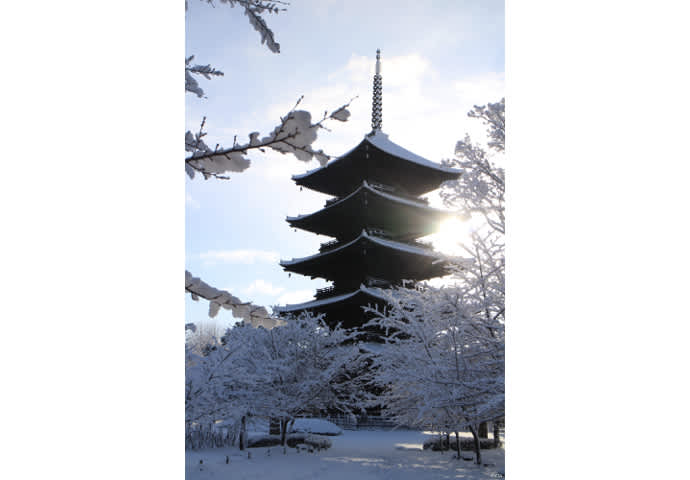
Fushimi-Inari Taisha is a photogenic shrine known for its lines of vermillion torii gates, making it a popular destination for sightseers. It has long attracted those coming to worship the god of abundant harvests and business success. The endless rows of torii gates (known as the Senbon-torii, or Thousand Gates) form tunnels that show up vividly in the clear light of fall and winter, bringing delight to all those who come to pay their respects.
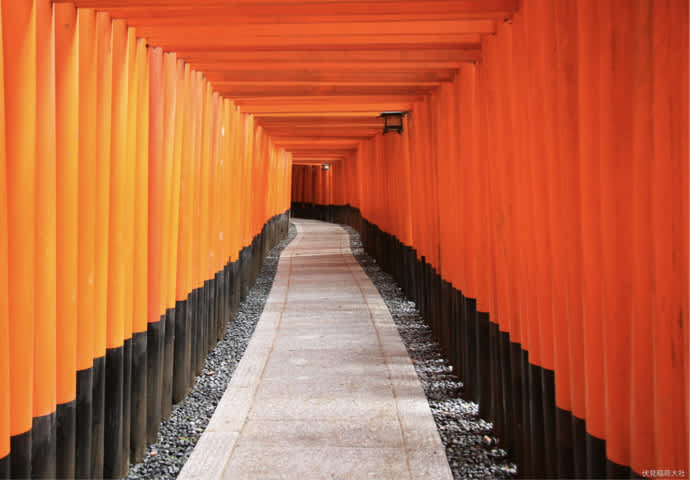
You can visit the official Kyoto City travel website (available in English) to search for more information on the city’s temples and shrines, or to see information on recommended locations in each season. Look around and see what captures your interest!
Contact information
Official Kyoto City travel website
Kyoto Geihinkan (State Guest House)
Kyoto Artisans Concierge
Nanzen-ji Temple
Toji Temple
Fushimi-Inari Taisha




















































